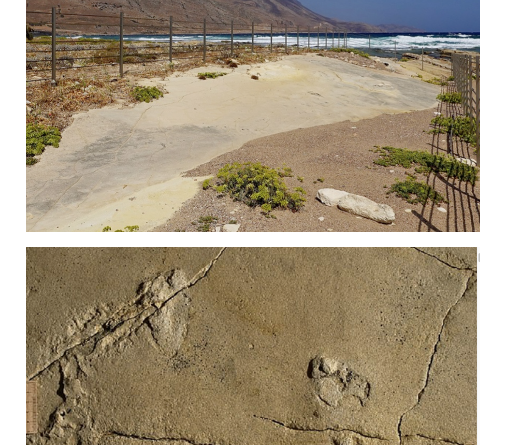Ancient footprints on the western edge of Crete – Τα ίχνη βάδισης του Τράχηλου Κισσάμου
According to the latest research the dating of the Cretan footprints sheds new light on the early evolution of human walking over six million years ago. (Press release 11th October, research team University Tübingen, Germany).
research the dating of the Cretan footprints sheds new light on the early evolution of human walking over six million years ago. (Press release 11th October, research team University Tübingen, Germany).
The oldest known pre-human footprints, discovered in the west of Crete in 2002, have been dated as being 6.05 million years old, about 350,000 years older than originally estimated, according to a scientific study published in the Nature journal Scientific Reports.
The fossil footprints were found on the seashore of the village Trachilos in western Crete, tetrapod footprints which show hominin-like characteristics from the late Miocene.
Though it remains unclear which species left them, the prints have a distinctly human-like form, with a similar big toe to our own and a ‘ball’ in the sole that is not found in apes.
Researchers from Germany, Greece, Sweden, the UK and Egypt led by Uwe Kirscher and Madelaine Bohme of the Senckenberg Center for Human Evolution and Palaeoenvironment at the University of Tübingen concluded that the footprints are the oldest direct evidence of a human-like foot used for walking.
The study of the researchers has been published in the journal Scientific Reports on 11th October 2021.
The Trachilos footprints are tetrapod footprints showing hominin-like characteristics from the late Miocene.
The tracks were originally discovered by Gerard D. Gierliński in 2002. During a visit to Trachilos, Gierliński found the tracks. Not planning to stay in Trachilos, Gierliński recorded the footprints in order to investigate them in the future. In 2010 he returned to Trachilos with other researchers to explore the tracks in detail.
The tracks were dated by using the underlying rock bed, predominantly sedimentary, and foraminifera, a type of algae that lives on sea floor. The study explains, “The coastal rocks at Trachilos lie within the Platanos Basin, and present a succession of shallow marine late Miocene carbonates and siliciclastics (…)”
Shortly after the research about the footprints was published, eight prints were chiselled out of the rock and stolen. According to the Greek newspaper Protothema.gr, the culprit was a high school teacher, who was later arrested by Crete authorities. The prints were later found in his house and on a farm.
Sources: https://www.ekathimerini.com/culture/1169585/crete-s-ancient-footprints/
https://www.wissenschaft.de/geschichte-archaeologie/fussspuren-eines-vormenschen-auf-kreta/
See also
- https://www.sciencedirect.com/science/article/pii/S001678781730113X
- https://www.dailymail.co.uk/sciencetech/article-10079539/Experts-identify-oldest-footprints-pre-humans-Crete.html


